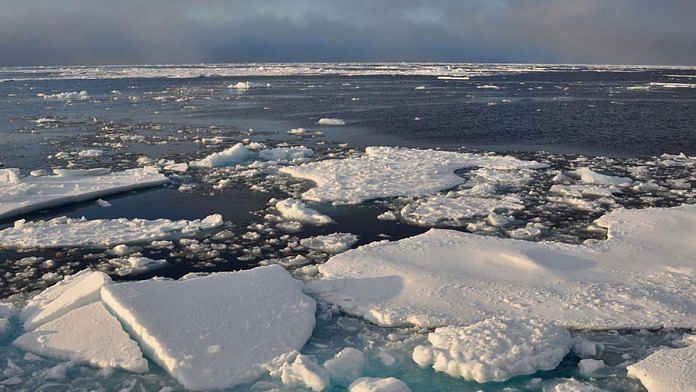New Delhi: Arctic sea ice became thinner as the frozen cover reduced by over half between 2005 and 2007 and is yet to recover, a new report found Wednesday. Scientists observed that Arctic sea ice underwent a “regime shift” — large, abrupt and persistent changes in the ecosystem structure — during this brief period wherein thick ice “deformed” to thinner and more uniform ice cover.
A report published in the London-based scientific journal Nature revealed that sea ice thickness has changed substantially since the 1990s.
Sea ice in the Fram Strait, the passage between Greenland and Svalbard in the Arctic Ocean consists of a myriad of ice types and thicknesses, reflecting its thermal and dynamic history before exiting the Arctic Basin. The thickness of ice ranges from thin sea ice that is less than 0.5 metres thick, ice that is 1.5–3 metres thick to much thicker ice up to 4 metres. However, this distribution has changed dramatically over the past three decades, highlighting the impact of global warming in the region.
By monitoring the Fram Strait — where 90 per cent Arctic sea ice passes through to reach the North Atlantic Ocean — scientists discovered that residence time – i.e the average time a mass or substance remains in a medium or place – of sea ice in the Arctic Basin dropped from 4.3 years to 2.7 years, in two steps, first in 2005 and then in 2007.
After this decline in residence time in Arctic-wide sea ice – which first occurred in 2005 and then in 2007 – a regime shift was observed where deformed sea ice thicker than 4 metres saw an abrupt reduction by roughly 52% to become thinner and more uniform ice cover, the study states.
The extent of Arctic sea ice exhibited negative trends, meaning ice in the basin is continuing to decline, both in summer and winter over the last three decades.
This sea ice data was collected using upward looking sonar (ULS) secured in the East Greenland Current in the western Fram Strait and covered a period from 1990 to 2019.
The report highlights a long-lasting impact of climate change on Arctic sea ice, reflecting environmental changes throughout the region. It suggests that the “irreversible loss” of sea ice thickness was a result of increased ocean heat in ice-formation areas.
This thinner and more uniform sea ice can also affect ocean mixing, and consequently ocean ecosystems below the ice as well, the study warned.
Also read: South Pole warmer by 40°C, North Pole by 30°C. Simultaneous highs alarm scientists



